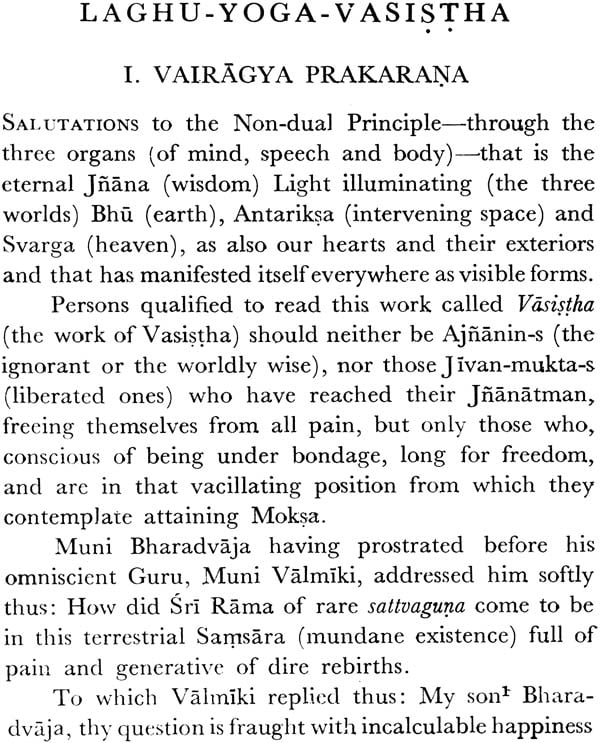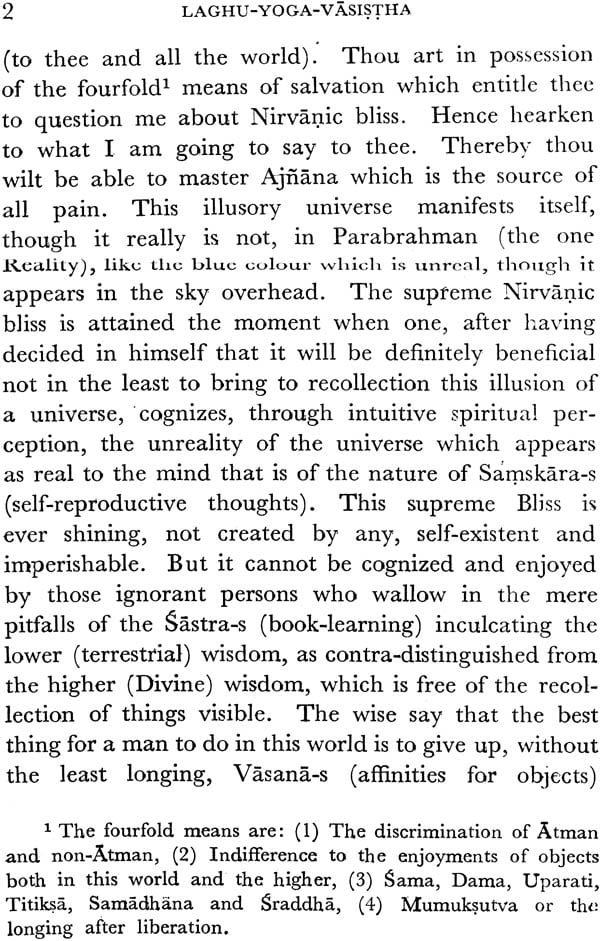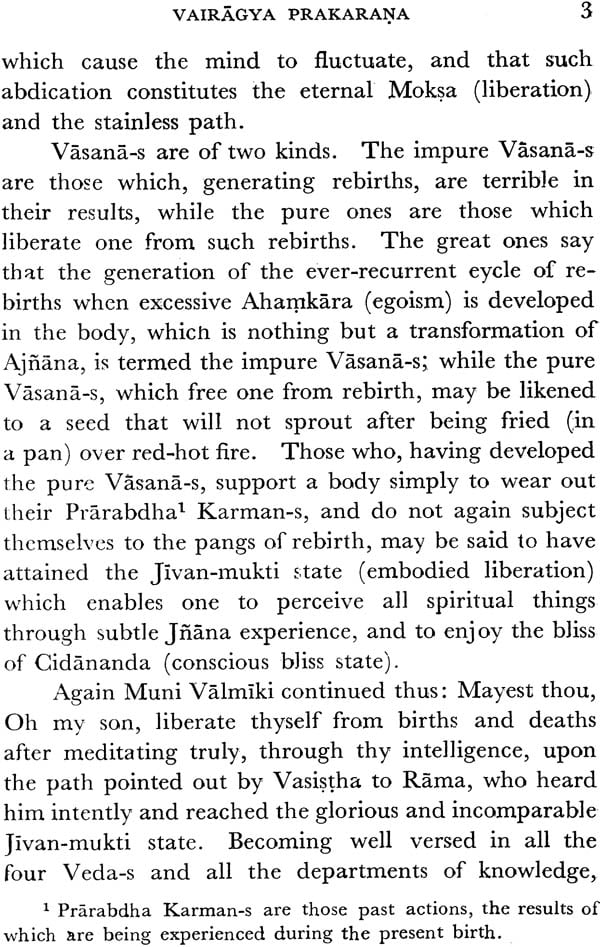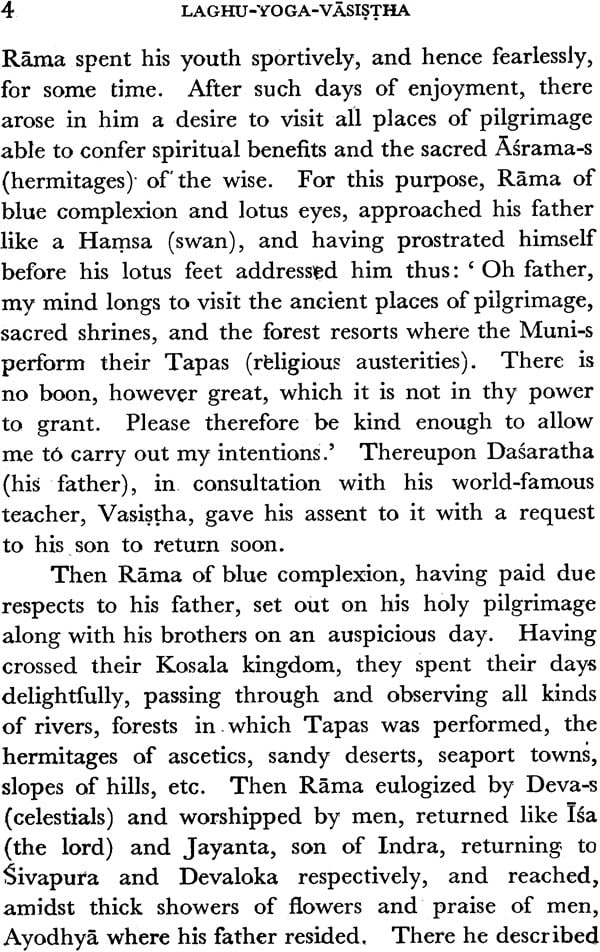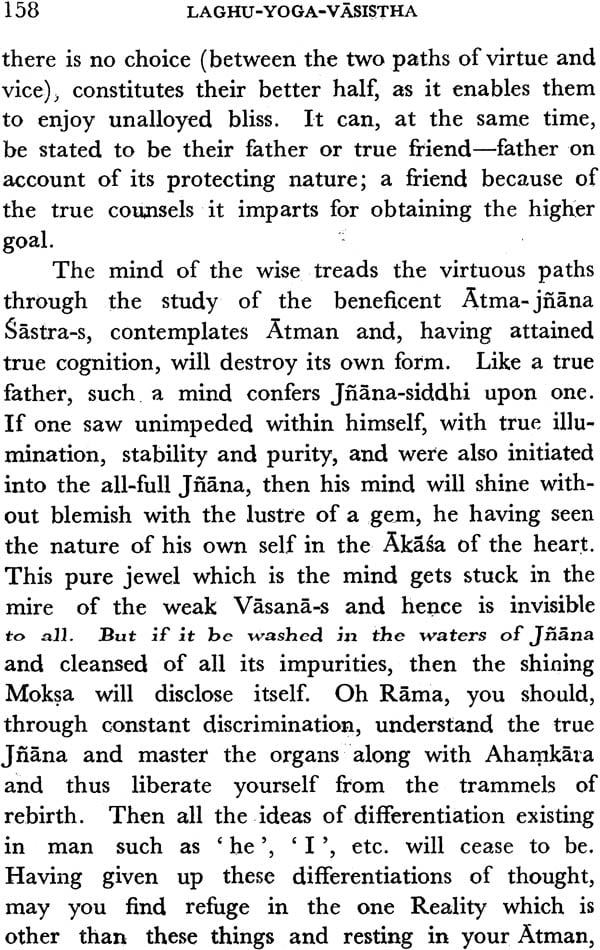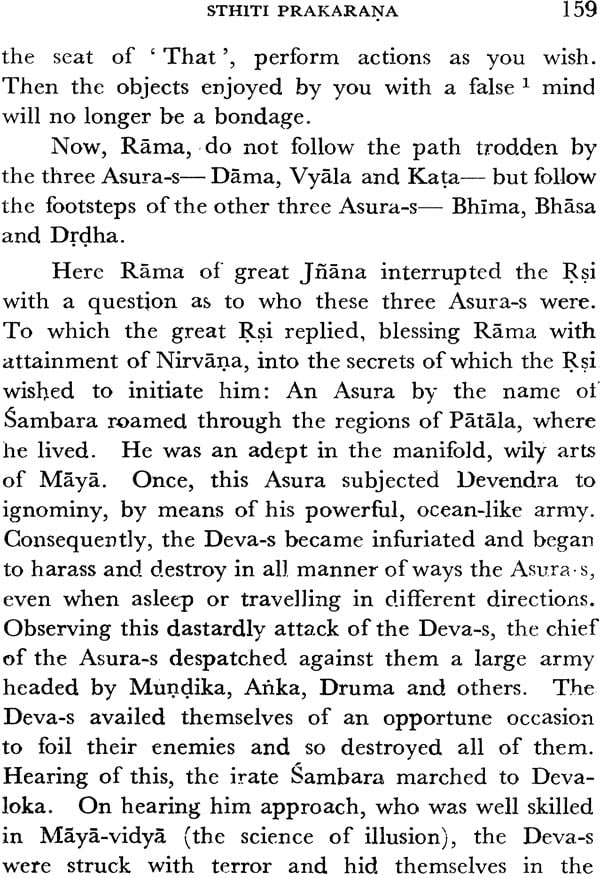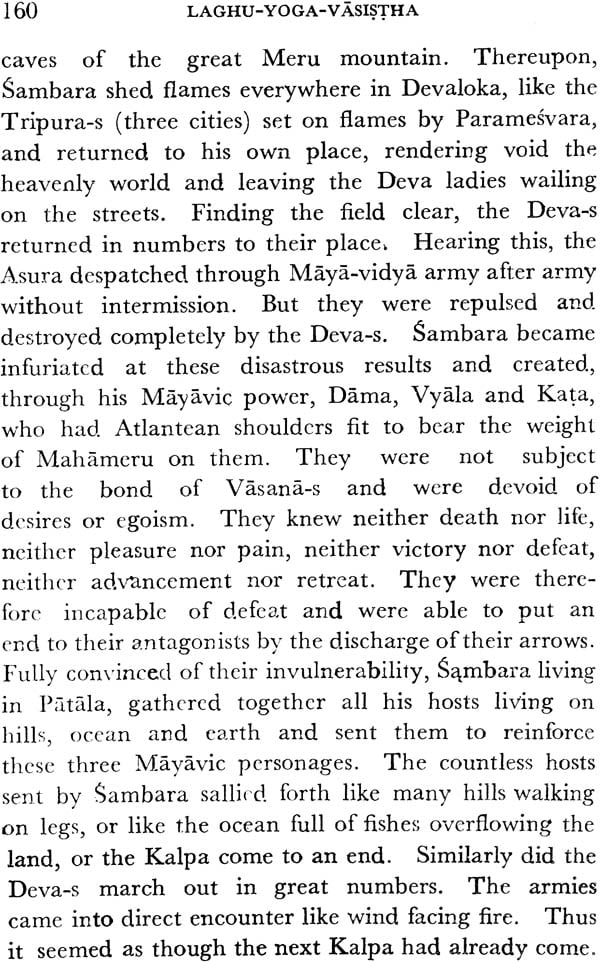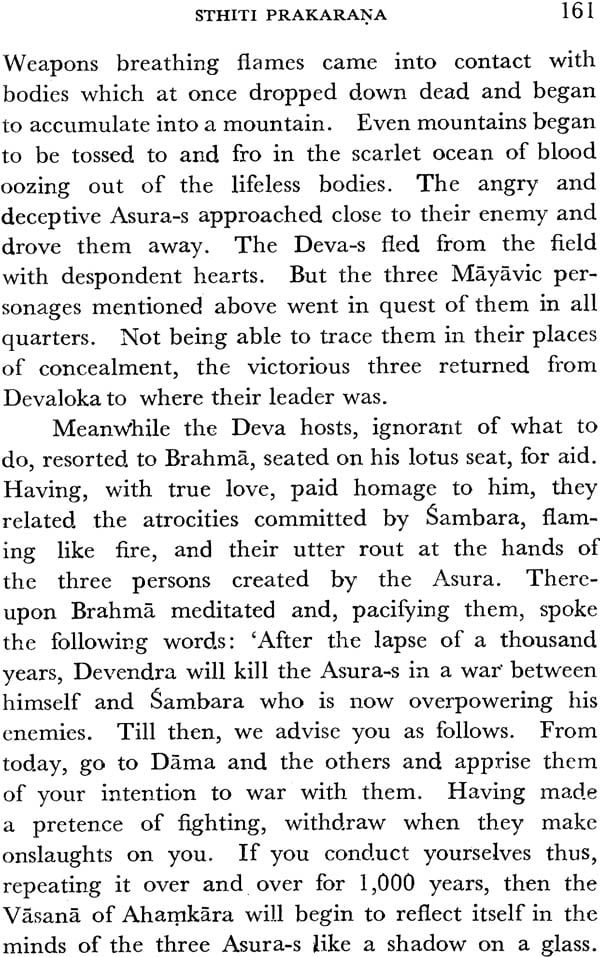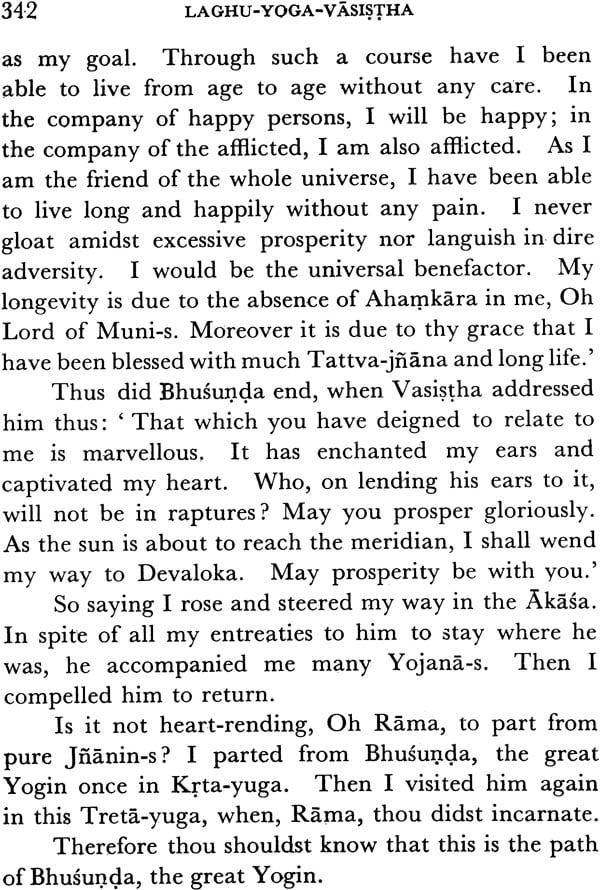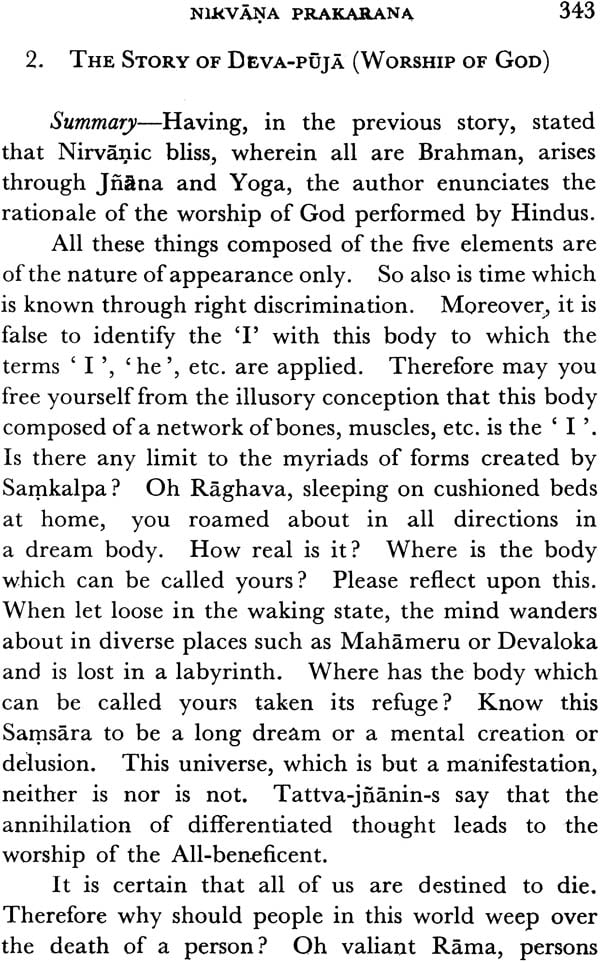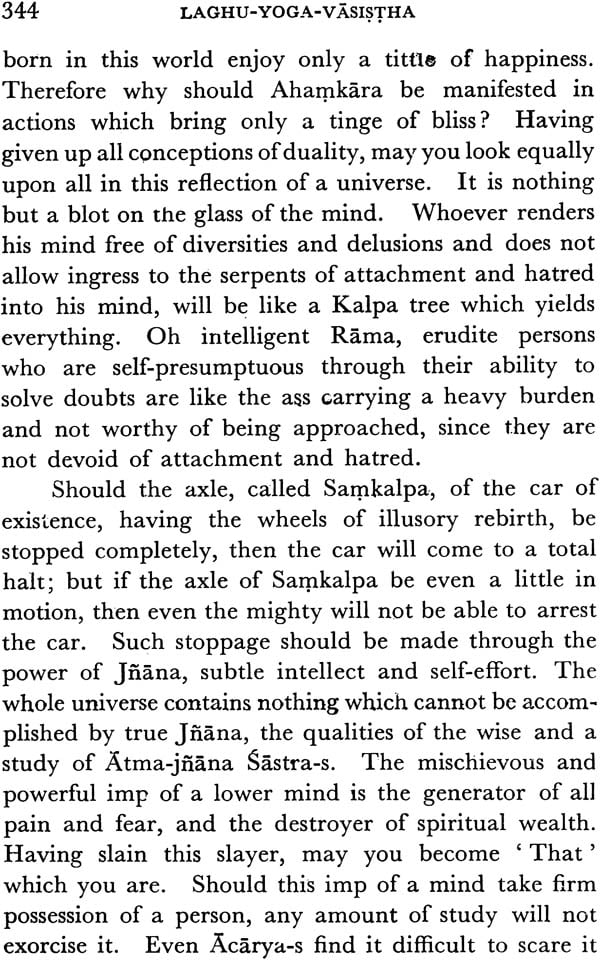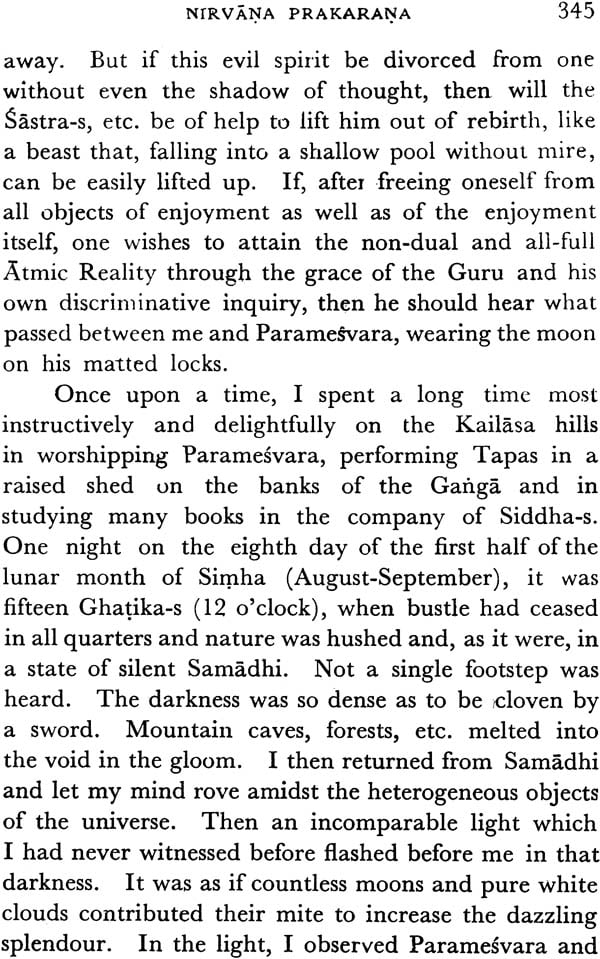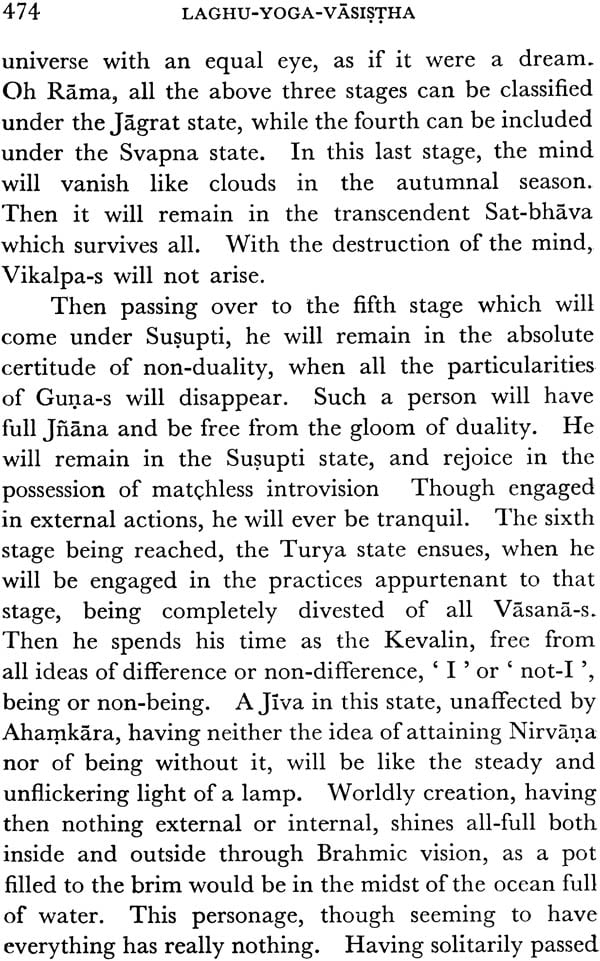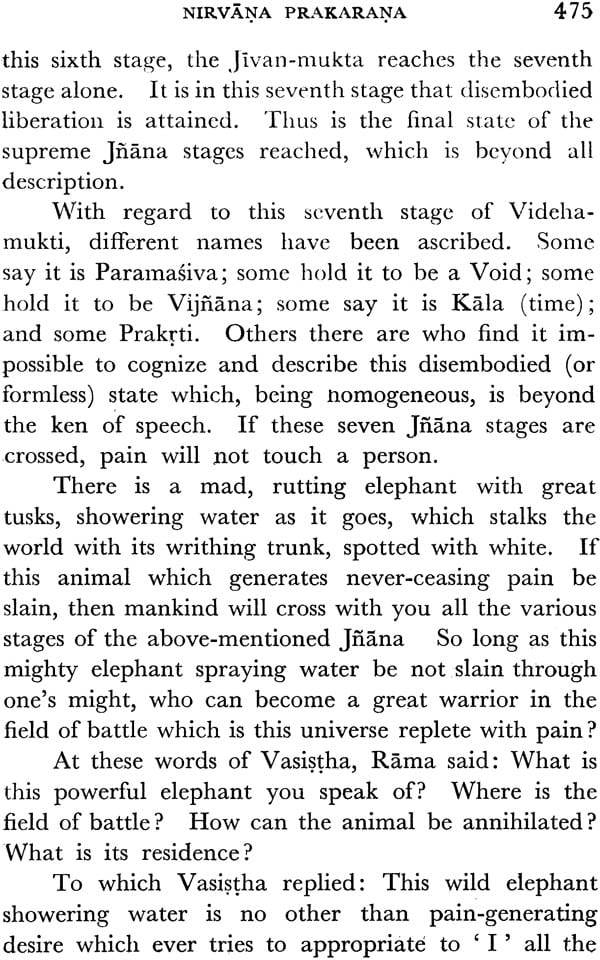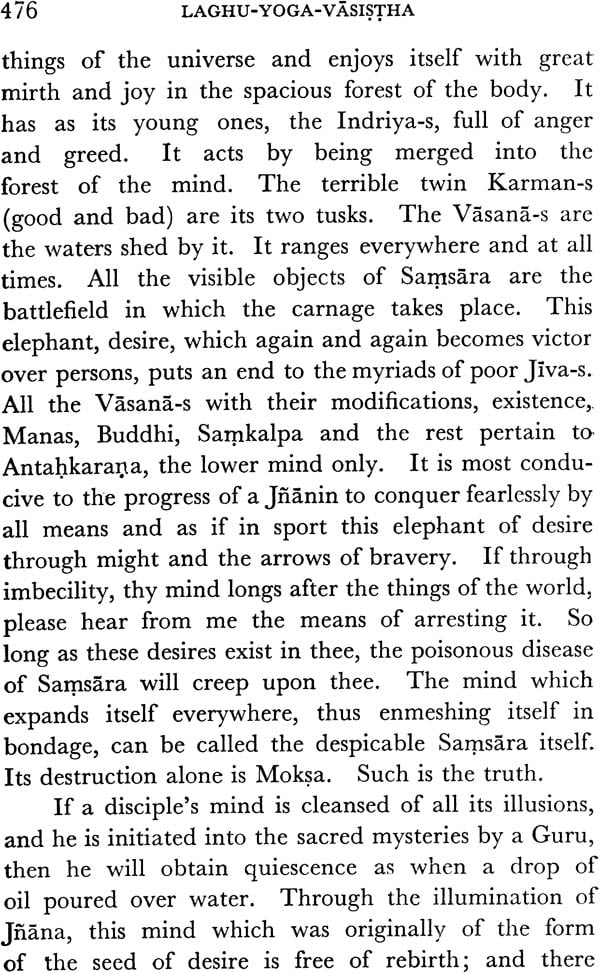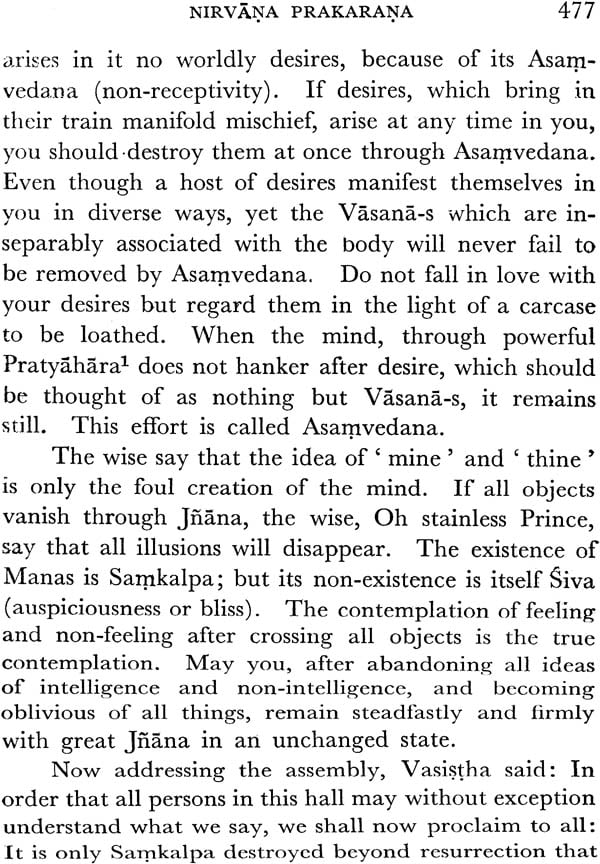
Laghu-Yoga-Vasistha (An Old and Rare Book)
Book Specification
| Item Code: | IDH281 |
| Author: | K. Narayanaswami Aiyer |
| Publisher: | The Adyar Library and Research Centre |
| Language: | English |
| Edition: | 2001 |
| ISBN: | 0835674975 |
| Pages: | 486 |
| Cover: | Hardcover |
| Other Details | 8.3" X 5.6" |
| Weight | 830 gm |
Book Description
K. Narayanaswamy Aiyer, son of Krishnaswami Aiyer, was born at Kazhukanimattam Village, Tanjavur District, South India, in the year 1854. he was the second of four brother, three of whom occupied fairly comfortable positions in life. One of them was the late K. Veeraswami Aiyer, a prominent Vakil of Tiruvarur in the early twenties of this century, and another, an engineer of the Public Works Department of the Government.
Educated at his village school at Kazhukanimattam and, late, at the Kumbakonam Town High School and at the Kumbakonam Government Arts College, he was a first grade pleader at Kumbakonam and made a reasonably prosperous living there. He had a son and two daughters.
He joined The theosophical Society during the presidentship of Col. H. S. Olcott and travelled very widely all over India including far places like Kabul and Srinagar at a time when communications were poorly developed (1905-18), spreading the message of the Theosophical Society.
His task was also to help in weaning away Indians from the Christian missionary influence and from an imitative way of life patterned on the West. His rare persuasiveness and lucidity of expression brought good results. His personal life as a real Samnyasin carried profound conviction everywhere. His scholarship in Sanskrit and English and his deep Knowledge of his own and western religions earned for him a great measure of contemporary veneration. He died in "December 1918 at Pudukkottai on one of his lecture tours. An assiduous writer, his articles regularly appeared in The Theosophist, then published from London. Hw wrote six major books: Hindu God Universal, Thirty Minor Upanisad-s , Thirty-two vidya-s, Purana-s in the Light of Modern Science, Yoga: Lower and Higher and a translation of Laghu Yoga Vasistha. A minor work which attracted attention particularly among Western scientists was Prof. Bergson and Hindu Vedanta Which appeared in a pamphlet form.
Though K. Narayanaswamy Aiyer passed away some fifty-five years ago, the demand for some of his works has persisted. The Adyar Library and Research Centre has reprinted two of his works: The Laghuyoga-vasistha and Thirty-two Vidya-s, half a century after his demise.
The Laghu-Yoga-Vasistha is an abridgement by Abhinanda of the well-known Yoga-vasistha, containing the essentials of Advaitavedanta, illustrated by allegorical stories. K. Narayanaswami Aiyer's free translation, first printed in 1896 and reprinted once again, makes the wisdom contained in the text accessible to the lay public.
The origin of I-consciousness, its growth and quiescence, the nature of maya and the way to overcome it, the states of Jnana and ajnana, and freedom from vasana-s, pure and impure, are among the topics on which it throws light. 'Jnana alone is the true God and the flowers, etc. with which God has to be worshipped are equal vision for all, contentment of mind, and spiritual wisdom', declares the sage.
This is a work for true aspirants who are in the world, but seek not to be of it.
The Yoga-Vasistha is a popular text on Advaita Vedanta, Puranic in form and philosophical in content. It is also known by other names like Arsaramayana, Jnanavasistha, Maharamayana, Vasistharamayana and Vasistha and is ascribed to sage Valmiki himself. It is in the form of replies given by Vasistha to Sri Rama's queries regarding philosophical problems of life and death, and human suffering, and treats the essentials of Advaita Vedanta. It seems to advocate the drsti-srsti-vada which holds that the world exists only so long as it is perceived: manodrsyam idam sarvam 'the whole world of things is the object of the mind'.
The Laghu-Yoga-Vasistha is an abridged version of the Yoga-Vasistha, compiled by one Abhinanda of Kashmir. For the first three Prakarana's there is a commentary called Vasistha Candrika by Atmasukha, and for the last three Prakarana-s Mummidi Devaraya wrote the Samsaratarani commentary (both published with the text, Nirnayasagar Press, Bombay, 1888).
This English rendering of the Laghu-Yoga-Vasistha by the late K. Narayanaswami Aiyer was first published in 1896 (Thomson & Co., Madras) and then in 1914 (Hoe & Co., Madras). It is a free translation trying to present the ideas contained in the text in a lucid manner, using at times the explanations of the Sanskrit commentaries. The Adyar Library is again bringing this work into print as there has been a demand for it. Some editorial changes have been made. A biographical sketch of the translators has also been included in this edition.
It is intended to give here a short introduction to, and an analysis of the Laghu-Yoga-Vasistha. The analysis cannot be an exhaustive one, as it would have then to run through many pages and form another book. There are, at present known to us, two works by the name of Yoga-Vasistha, the larger one going by the name of Brhad-Yoga-Vasistha and the smaller one, Laghu-Yoga-Vasistha. The term brhat means 'great', while laghu signifies 'small'. Vasistha is because this work emanates from Rsi Vasistha as will be seen later on. Though the book has the appellation, Yoga-Vasistha, it treats of Jnana only, and practical Yoga is dealt with in two stories in this work. Even there, it is said that the pure Raja-yoga is meant and not Hatha-yoga. The word yoga seems to have been used in the title of this work in its generic sense, including Jnana-yoga and other Yoga-s as in the Bhagavadgita.
Of the two above-mentioned works, the smaller one is an abridgment of the bigger, and contains about 6, 000 Grantha-s, whereas the latter contains 36,000. The commentary on the former has the same number of Grantha-s as the original, whereas that of the latter comprises 74,000 Grantha-s, which with its original totals a lakh. In the abridged text, almost all the words are reproduced verbatim from the bigger one, the work of the author having been generally to clip the bigger version of its expansive descriptions and so on; so that in the work before us, the quintessence is extracted. This work seems to have been undertaken by one Abhinanda, a great Pandit of Kashmir. The authorship is attributed to Rsi Valmiki, the author of the Ramayana, who is said to have related the whole of the Yoga-Vasistha to Rsi Bharadvaja as having occurred between Sri Rama and Rsi Vasistha. But of this, later on. The larger work seems to have been partially translated by a gentleman hailing from Bengal. This one, though named small, is yet big enough.
This work is, in the words of Madame H. P. Blavatsky, 'meant for the few only'. In the phraseology of this work, it is intended neither for those Ajnanin-s (the worldly-minded) who welter in the sea of Samsara, without being indifferent to worldly things, nor for those higher spiritual personages who have reached a state of adeptship, so as to be above all advice. Hence, it is written in the interest of those who have become indifferent to worldly things and crave for spirituality to become a potent factor in their daily live. Fancy a work like The Voice of the Silence put into the hands of a worldly person of decidedly materialistic views; he will throw it away in disgust. Similarly will this work not appeal to a person who has not caught even a glimpse of the higher life and principles. A person of true Vairagya, should he wish to have not only some hints cast on the nature of the cosmos, Manas (mind) and the Universal Spirit from the idealistic standpoint, but also have some rules for guidance in his daily, practical life with the proper illustrations leading towards occult knowledge, will here find, in my opinion, a mine of knowledge to cogitate upon.
There are some peculiar traits in this work, distinguished from other spiritual works in the Sanskrit literature. As all know, the Veda-s and the Upanisad-s are so mystic in their nature in many places that their real meaning is not grasped clearly and all except true occultists-rare to find in this world-interpret them in different ways, one holding that the Veda-s inculcate nature worship, another imposing upon them a diametrically opposed view, and so on. Even in the ten Upanisad-s, all the metaphysical-leaving aside for the present, as impossible, the occult-theories have not been worked out in a systematic manner; only some clues have been vouchsafed there-upon. Taking the Purana-s in their dead letter, our Pandits generally have found them replete with indecent and absurd stories and thrown them into a corner; and hence the nickname of Purana-s has been applied, in ordinary usage, to refer to anything that is a farrago of fictions and absurdities. But for the timely resurrection of them by H. P. Blavatsky, with the profound ray of light shed upon them by her, almost all of us would, by this time, have unanimously buried in oblivion all works savouring of Purana-s. Even she has not thrown full light on them, as she probably was note privileged so to don. As regards Itihasa-s. Namely the Mahabharata and the Ramayana, they are considered as so many stories only and as such as much in favour with our orthodox Pandits who do not care to go above worldly things. Vedanta soars high in the region of the Absolute with its theories and words; and our metaphysicians of the old school in India, carrying the notion of the physical world up there, try to solve the problem of the homogeneity or otherwise of the Infinite, wrangling with one another, as our Advaitin-s, Visistadvaitin-s and Dvaitin-s are doing in their everyday lives, so much so that their arguments end in mental gymnastics only and with nothing practical in their lives. Here a curious instance occurs to me. One day an Advaita Pandit lectured in a certain place about Brahman being nirguna (or without any attributes) and the only Reality, and argued with great vehemence against his adversary. Next day, seeing him circumambulate an idol in a temple, I asked him to whom he was paying respects. The Pandit merely laughed over the affair without an answer. Thus are most of our Pandits, theorizing only, with nothing practical about them, and soaring into the region of the Absolute without a proper knowledge of the basic foundations of Vedanta.
But the Yoga-Vasistha has followed a new and distinct path. At first, it enunciates an aspect of the Vedanta doctrine in its several bearings and then elucidates it with beautiful stories. It gives also rules of guidance for the conduct of life in the world, these also being illustrated in the stories. As in the Purana-s, we have not to rack our brains over the slight hints thrown out and to give up sometimes in despair the problems before us.
Secondly-This book serves as a ladder wherewith to climb from the Sesvara Samkhya doctrine of Patanjali as given in his Yogasutra-s to the Maya conception of the Advaita Pantheists, and thus renders possible a reconciliation between them both. Through a study of Patanjali's Yogasutra-s, it is clear from Book III, aphorism 17, that the cause of all pain is the conjunction of the seer with the visual, or the subject with the object; the conception of 'I' having been brought about by the identification of the subject with the object. Through Saksatkara Anubhava or direct realization, the Yogin finds he is one with the subject and does not find them the reality of the object. It is this that is illustrated in the story of Suka.
| Preface | vii | |
| Introduction | ix-xxxiii | |
| I | VAIRAGYA PRAKARANA | 1-39 |
| 1. The Story of Suka | 31 | |
| II | MUMUKSU PRAKARANA | 40-51 |
| III | UTPATTI PRAKARANA | 52-144 |
| 1. The Story of Akasaja (the son of Akasa) | 52 | |
| 2. The Story of Lila | 65 | |
| 3. The Story of Karkati | 89 | |
| 4. The Story of Aindava (The son of Indu or the Moon) | 103 | |
| 5. The Story of Deceitful Indra | 106 | |
| 6. The Story of Manas (Mind) | 109 | |
| 7. The Story of a Bala (Lad) | 114 | |
| 8. The Story of a Siddha | 127 | |
| 9. The Conclusion of Utpatti Prakarana | 124 | |
| IV | STHITTA PRAKARANA | 145-201 |
| 1. The Story of Sukra | 145 | |
| 2. The Story of Dama, Vyala and Kata | 154 | |
| 3. The Story of Bhima, Bhasa and Drdha | 164 | |
| 4. The Story of Dasura | 170 | |
| 5. The Story of Kaca | 196 | |
| 6. The Conclusion of Sthiti Prakarana | 200 | |
| V | UPASANTI PRAKARANA | 202-231 |
| 1. The Story of King Janaka | 202 | |
| 2. The Story of Punya and Pavana | 211 | |
| 3. The Story of the Great Bali | 222 | |
| 4. The Story of Prahlada | 233 | |
| 5. The Story of Gadhi | 248 | |
| 6. The Story of Uddalaka | 258 | |
| 7. The Story of Suraghu | 275 | |
| 8. The Story of Bhasa and Vilasa | 285 | |
| 9. The Story of Vitahavya | 289 | |
| 10. The conclusion of Upasanti Prakarana | 306 | |
| VI | NIRVANA PRAKARANA | 222-470 |
| 1. The Story of Bhusunda | 322 | |
| 2. The Story of Deva-puja (Worship of God) | 343 | |
| 3. The Story of the Bilva Fruit | 357 | |
| 4. The Story of Sila, a Granite | 360 | |
| 5. The Story of Arjuna | 362 | |
| 6. The Story of the Hundred Rudra-s | 367 | |
| 7. The Story of the Vetala (Goblin) | 373 | |
| 8. The Story of Bhagiratha | 378 | |
| 9. The Story of Sikhidhvaja | 384 | |
| 10. The Story of Kaca | 438 | |
| 11. The Story of Mithya-Purusa, the Illusory Personage | 442 | |
| 12. The Story of Bhrrigisa | 445 | |
| 13. The Story of Iksvaku | 449 | |
| 14. The Story of a Muni and a Hunter | 461 | |
| 15. the Conclusion of Nirvana Prakarana | 466 | |
| Index | 481 |
